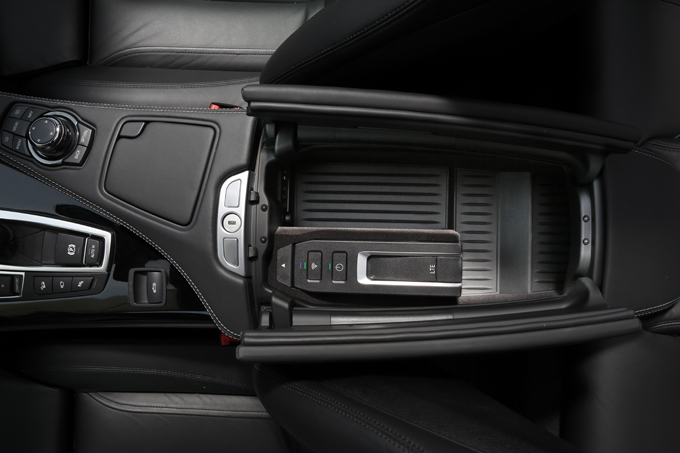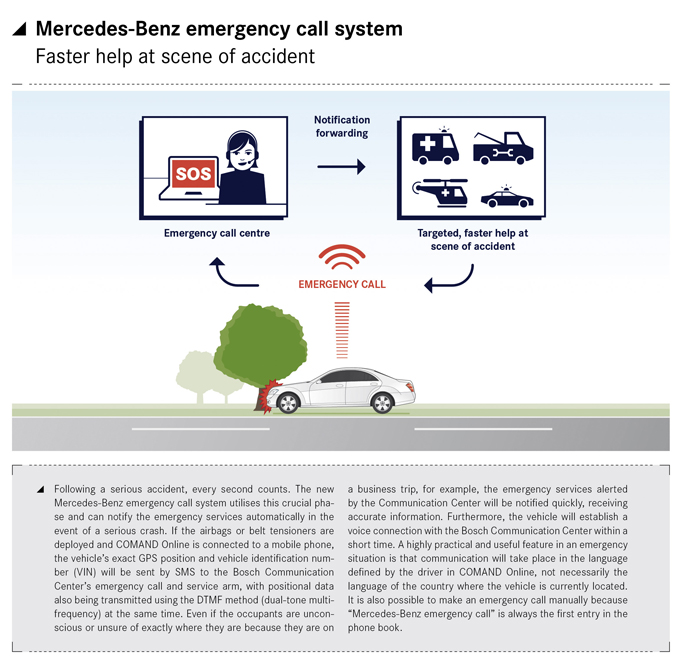Automakers and Tier-1s Launch Innovative Technologies
MB's eCall automatically notifies emergency services after serious mishap
2013/04/10 | By Quincy LiangGlobal automakers and tier-one parts suppliers continue to surprise the auto world with innovative, practical and necessary products to enhance driver comfort and safety.
One of them is the international automotive tier-one Continental AG, who recently claimed that it has received the "Autonomous Vehicle Testing License"– a state approval from the Nevada Department of Motor Vehicles (DMV) to test automated driving on the state's public roads. Continental's testing license is for the company's highly automated vehicle, and represents the first license granted by the Nevada DMV to an automotive supplier.
The Germany-based company claimed that they are perfectly positioned to develop and launch series production of solutions for partially automated systems for customers by 2016; and will be able to develop the first applications for highly and ultimately fully automated driving, even at higher speeds and in more complex driving situations, ready for production by 2020 or 2025.
Continental's current highly automated vehicle is designed to always have a driver monitoring the vehicle behind the wheel, unlike a completely driverless vehicle. The automated vehicle can accommodate multiple driving scenarios. Utilizing four short-range radar sensors (two at the front, two at the rear), one long-range radar and a stereo camera, the vehicle is capable of cruising down an open freeway as well as negotiating heavy rush-hour traffic. Taking advantage of Continental's sensor fusion technology as part of the ContiGuard safety concept, the vehicle is able to track all objects as they enter into the sensors' field of view. The object information is then processed and passed on to the control unit to control the vehicle's longitudinal and lateral motion via signals to the engine, the brakes and the steering system.
The equipment in Continental's highly automated vehicle differs from the customized sensors and tailor-made actuators in other automated vehicles, the company claimed. The vehicle, which has logged more than 15,000 miles (24,000 kilometers), is built primarily with equipment that is already available in series production. Continental's short term goal is to relieve the driver of tedious and monotonous activities, such as driving on highways with minimal traffic or in low-speed situations like traffic jams.
Although the concept of fully automated driving is valid, it is not yet fully viable.
Continental's highly automated vehicle, however, the company said, is an intermediate step toward fully automated driving. Continental's vehicle brings Continental closer to achieving the company's Vision Zero – the goal of reaching zero accidents and zero fatalities on the roadways.
Continental said that it would continue real-world evaluations with this vehicle. From 2016, the company said, partially automated systems may therefore be assisting drivers in "stop & go" situations on the freeway at low speeds of up to 30 km/h.

BMW's Hotspot LTE
Another new technology product is the newly launched BMW Car Hotspot LTE, which now brings Long Term Evolution (LTE) high-speed mobile internet access to the road.
The innovative device, which acts like a router in the home, provides internet access for mobile client devices. Passengers can enjoy high-speed internet surfing on as many as eight different mobile devices simultaneously. Using the new LTE wireless technology, the BMW Car Hotspot LTE takes the mobile internet experience to a whole new level.
All that is required apart from the BMW Car Hotspot LTE is an LTE-capable SIM card, which is simply inserted into the hotspot. The first time a mobile device is connected to the BMW Car Hotspot LTE using the mobile device's WLAN (wireless local area network) interface, an eight-digit code must be entered. This is a one-off requirement.
The procedure is even simpler if the mobile device is equipped with an NFC (Near Field Communication) interface. In this case, the WLAN connection is automatically established simply by briefly placing the NFC-capable device on top of the BMW Car Hotspot LTE. This is the first time NFC functionality has been offered in the car. If the customer's device is not NFC-capable, the BMW Car Hotspot LTE also offers WPS (WiFi Protect Setup) as a further easy solution for establishing a WLAN connection.
Using this method it is possible to establish a secure connection between the hotspot and a mobile device situated within a range of three meters simply by pressing the hotspot's “connect” button once and without entering a PIN.
The Hotspot LTE accessory is designed for operation in any vehicle of the BMW Group equipped with a telephone docking station, as well as all vehicles if plus some accessories. The docking station provides the power supply and ensures optimal reception. When placed in the BMW docking station, the BMW Car Hotspot LTE connects to the internet using the vehicle aerial. This means that reception cannot be impaired for example by tinted windows, while also preventing radiation inside the vehicle. But it is also possible to use the BMW LTE Hotspot even without a docking station. In this case, using an optionally available adapter and mini-USB cable, the power is provided by plugging the BMW Car Hotspot LTE into the cigarette lighter. This means the hotspot can be used in any vehicle.

Mercedes-Benz eCall System
The German luxury-car brand and famous automotive-technology innovator, Mercedes-Benz recently claims that it will offer eCall in 19 European countries from 2013.
In June 2012, in fact, three years ahead of the planned obligatory date set by the European Commission (EC), Mercedes-Benz eCall, the vehicle emergency call system, was launched. In the event of a serious accident, the emergency services can be notified automatically and be informed of the precise location of the accident and the car model within just a few minutes.
The Mercedes-Benz emergency call system is standard in the latest version of the COMAND Online multimedia system. Except for possible mobile phone charges, the Mercedes-Benz emergency call service is completely free of charge to Mercedes-Benz customers. The service is now available in 19 European countries.
After a serious accident every second counts, Mercedes says, and the Mercedes-Benz emergency call system uses this crucial phase and can notify the emergency services automatically after a serious crash. If the airbags or belt tensioners are deployed and COMAND Online is linked to a mobile phone, the precise GPS position of the vehicle and the vehicle identification number (VIN) are sent via text message (SMS) to the emergency call centre of the Bosch Communication Center, and at the same time the location data are transmitted via DTMF (dual-tone multi-frequency signalling). Even if the occupants are unconscious, or for example are on holiday and do not know exactly where they are, the Communication Center can inform the emergency services quickly and precisely.
In addition, the vehicle will quickly set up a call to the Bosch Communication Center. And a particularly practical feature which can be helpful in an emergency: the call is not conducted in the language of the country, but in the language which the driver has programmed in to COMAND Online. An emergency call can also be made manually, as "Mercedes-Benz emergency call" is always the first entry in the phone book.
Geographically, eCall is being phased in several stages: on 1 June 2012 the automatic emergency call system was introduced in nine European countries – Germany, France, Italy, Spain, the U.K., Austria, Belgium, the Netherlands and Switzerland. From 1 January 2013, 10 more will follow: Norway, Finland, Lithuania, Hungary, Romania, Bulgaria, Greece, Portugal, Luxemburg and Malta.
As part of the eSafety initiative, the EC has ruled that by 2015 eCall technology should be available in all new cars. EU Commission sources have found that with the help of an immediate eCall giving the coordinates of the accident scene, the time the emergency services take to arrive could be reduced by 50% in rural areas and 40% in towns. This could mean up to 2,500 fewer road deaths per year in the EU.




